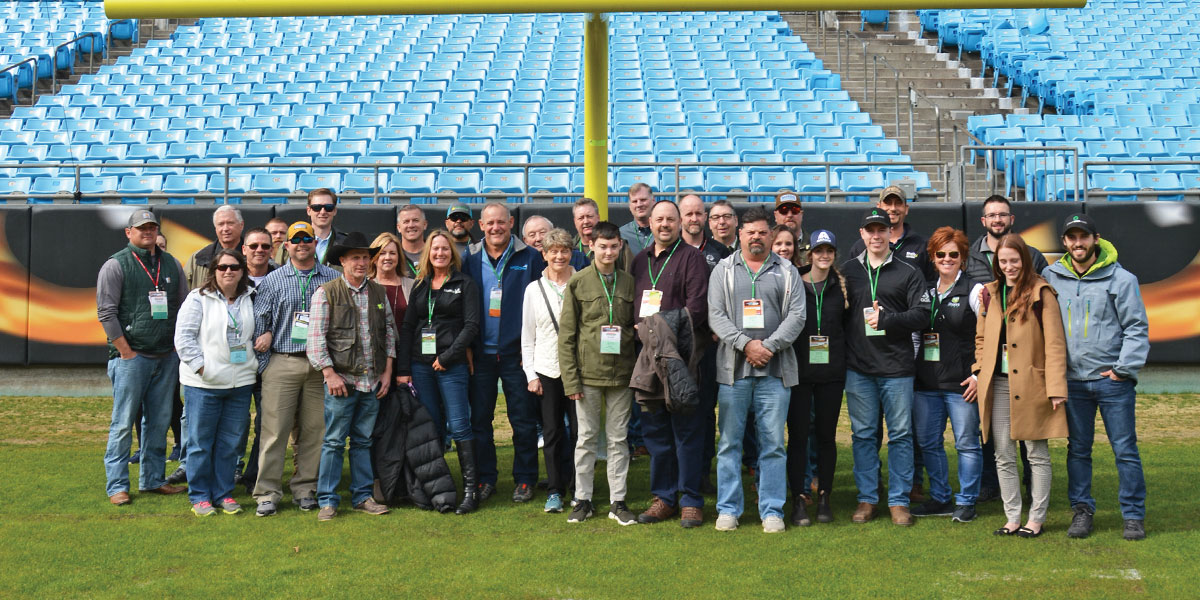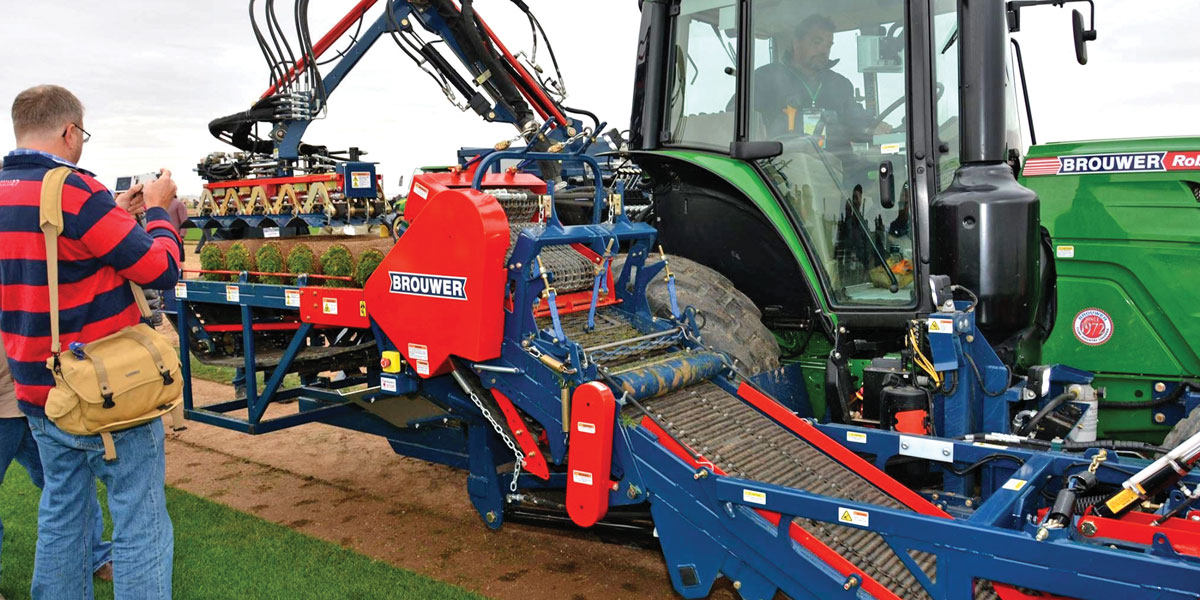A cross-section of information that switched between education and production but with an overarching theme of leveraging change was heard at this year’s Turf Producers International (TPI) Conference. GROWTH talks to Karen Cooper, TPI’s Executive Officer, and other delegates to give you an insight into some of the take-home messages gained from the key turf calendar event.


Growers think production everyday so to have that interwoven throughout the education sessions of the recent TPI 2019 Education Conference was an ingenious idea in terms of drawing growers to the event. Held at Charlotte in North Carolina in February, the two-day event had more than 450 TPI members from nine countries and 36 American states.
Karen Cooper, TPI’s Executive Officer, concluded that it was an exciting week of learning, networking and meeting new and old friends.
“The two days kicked-off with more than 150 people travelling to Charlotte Motor Speedway (home of the famous NASCAR Cup Series), Hendricks Motor Sports, Bank of America Stadium (home of the NFL’s Carolina Panthers) and BB&T Ballpark (home of the triple A Charlotte Knights),” she explained.
“A special highlight for most delegates was having the chance to ride around the Charlotte Motor Speedway in vans at speeds exceeding 80mph (about 130kms/hour). The Stadium and Ballpark tours were full of insider information about game day preparations and field maintenance for high traffic areas.”
Leveraging Change into today’s turf business

Above: Left – Shawn Rhodes and Right – Karen Cooper
The Education Sessions began with the theme of change as keynote speaker Shawn Rhodes (left) of Shosin Consulting opened the Conference with the talk Creating a Pivot Point: Leveraging Change without Sacrificing Results.
It was an entertaining and engaging opening address with everyone on the edge waiting for the punch line, which when delivered was very clever. Basically, he was inspiring everyone to live with the mantra that – “You have 15 seconds to live” – so live life to the fullest.
His general thoughts were on:
- Training. Keeping it – Engaging. Pertinent.
- Training. Has to help the business immediately.
- Training. Has to improve the business immediately.
He also eluded to the fact that a business should always consider just how training could improve and positively impact the customer.
Karen said that many of the other talks and sessions seemed to have the same idea (about leveraging change) —as an industry.
“We must constantly be willing and able to adapt to change in order to grow,” she said.
“We tried to find a balance this year between research-based talks designed to provide our members with cutting edge and up-to-date information from leading turfgrass researchers and information-sharing panels from experienced members who could share the ideas and processes they have implemented on their farms and in their businesses.”
“We tried to find a balance this year between research-based talks … and information-sharing panels from experienced members who could share the ideas and processes they have implemented on their farms and in their businesses.”
Over the next few editions GROWTH will cover some of the keynote speakers which included:
- Principles and Practices for Extending Sod Shelf Life – research which revolved around shelf life but equally age of turf from paddock re its longevity once harvested. Ongoing research suggests that other practices, outside of harvesting healthy grass that’s not too thatched or over fertilised and keeping the sod cool during transport, are being considered to help extend the time that sod can remain on a pallet.
- Plant and Soil Interactions for Turfgrass Producers – this topic tweaked the interest of all turf growers and simply stressed the need for good soil testing on all the farms and then being able to properly interpret the results. Of note was the advice that growers must stop throwing high pH chicken manure on the soil and add iron to amend yellows. Gypsum was also advised to remedy high sodium soils but is not required regularly unless the soil has a sodium issue and probably not required for Zoysia varieties. Take home message – do soil testing!


Future networking
Karen explained that the sessions were also designed to create opportunities for future networking.
“Last year, one member told me they were unsure about approaching experienced growers they didn’t know so we hope that after hearing some of these members speak on their experiences, it will be easier to approach them in order to make valuable connections and share ideas,” she said.
“We carried this theme into the networking lunch where attendees were asked to sit with individuals, they didn’t previously know well so they could make new connections.”
Using the ‘right’ words to promote turf
Another topical issue to come out of the Conference evolved from the session on the Natural Turfgrass Consumer Research where it was suggested the industry needed to customize its message to the various consumers of turf. This research, conducted by FleishmanHillard, was commissioned by the TPI who has contracted the Company to run their public relations program.
Karen explained that “… FleishmanHillard had carried-out extensive research, on the TPI’s behalf, to determine the types of opinions and the basic levels of understanding held by the general public about our product.
“Their research found that terms such as turfgrass, sod, and even natural turfgrass all had led to some degree of confusion about what our members were selling and whether or not it was actual grass or how it was related to artificial/synthetic playing surfaces.
“This research also found that the phrase that was the clearest to the largest numbers of people was ‘natural grass’. No matter what their feelings or level of familiarity was with any of the other possible terms, pretty much everyone could agree on what natural grass was.
“So, based on this research, we will use that wording in our publications, on social media, and whenever we work with the public or other stakeholders, because no matter how other industries want to label or brand their product, at the end of the day, we are the ones producing actual natural grass.”

Price of turf
A topic close to many Australian turf growers’ hearts, and purse pockets, is pricing turf at its true value. This was another well-covered and discussed item at the TPI conference with Ben Campbell (below) from the University of Georgia addressing What Drives the Market: Pricing, Marketing & Forecasting.

Ben stressed that growers needed to be aware as to how the turf market was evolving and what changes would mean to their business. In terms of pricing, he suggested that growers find the best pricing strategy that suited their business keeping in mind all the costs of production. And finally, he discussed various ways to forecast the demand of turf and then how these forecasts would drive a grower’s decision-making. He asked growers what they used as their forecasting methods, suggesting they should look at areas such as housing demands in regions.
This obviously led to an overall discussion about the value of turf and pricing it correctly.
Karen stressed that the TPI would “…never tell our members or even suggest to our members what they should charge and many members won’t even share with each other exactly what they charge.
“But we want to help members discover the true market value of their product and we want to help them understand what truly happens when they cut their prices.
“We want to be sure everyone understands that, for example, cutting your price 10% does not simply reduce your profit 10% and it doesn’t mean you need to sell only 10% more grass to make up that 10%.
“The shifts are exponential and because your fixed costs are just that—fixed—cutting your prices 10% means you need to produce much more grass than 10% (at least 30%) to cover that change.”
Karen added that “…a price war hurts everyone and selling a quality product at a loss helps no one. We will continue to find education opportunities for our members on this topic as it is a very important issue”.

